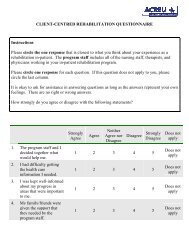Client-Centred Rehabilitation - Arthritis Community Research ...
Client-Centred Rehabilitation - Arthritis Community Research ...
Client-Centred Rehabilitation - Arthritis Community Research ...
Create successful ePaper yourself
Turn your PDF publications into a flip-book with our unique Google optimized e-Paper software.
1990), checklists of physician=s and patient=s<br />
behavior (Bryne and Long, 1976), and<br />
interviewing of patients after their<br />
consultation with physicians (Henbest,<br />
1985). Mead and Bower (2000) offer an<br />
extensive review of the studies evaluating<br />
the reliability and validity of various<br />
measures of patient-centred care (please<br />
refer to Mead and Bower for more details).<br />
In an empirical study, Mead and Bower<br />
(2000) compared the reliability and validity<br />
of three observation-based measures of<br />
patient-centred care. Their study evaluated<br />
Henbest and Stewart=s (1989) scoring of<br />
physicians responses to patient=s<br />
requests/offers, the Roter method of coding<br />
verbal statements of doctors and their<br />
patients which was derived from the Roter<br />
Interaction Analysis System (Roter, 1993),<br />
and the rating scale (Mead and Bower,<br />
2000).<br />
In terms of reliability, interrater reliability<br />
was highest for the Roter-based method<br />
(.71) and lowest for the rating scale (.34). In<br />
terms of validity, the three measures did not<br />
correlate highly with one another indicating<br />
that they did not measure the same<br />
construct. Also, the rater scale and the<br />
Roter-based method correlated highly with<br />
psychosocial aspects of physician<br />
consultation; the Henbest and Stewart<br />
(1989) method did not (Mead and Bower,<br />
2000).<br />
Qualitative Analysis<br />
Just as there is a tradition of quantitative<br />
analysis of patient-centred care in general<br />
practice, there is also a qualitative analytic<br />
approach. While this approach to evaluating<br />
patient-centred care advocates<br />
understanding the experience and context of<br />
the patient, the field research focuses more<br />
on the role of the physician. Future research<br />
needs to focus equal attention to both the<br />
14<br />
patient and the physician to reflect reality<br />
(McWilliam, 1995).<br />
2.3.2.5 Patient-<strong>Centred</strong> Care Outcomes<br />
in Medicine<br />
There were number of articles in the general<br />
practice literature focused on the outcomes<br />
of patient-centred care (Anderson, DeVellis<br />
and DeVellis, 1987; Brody, Miller, Lerman,<br />
Smith, and Caputo, 1989; Greenfield et al<br />
1988; Kaplan et al., 1989; Kinmonth, et al.,<br />
1998). The majority of such studies have<br />
focused on patients suffering from chronic<br />
illnesses such as diabetes, ulcers, breast<br />
cancer and high blood pressure (Greenfield<br />
et al., 1988; Kaplan et al. 1989; Kinmonth,<br />
et al., 1998) Outcomes of patient-centred<br />
care can be divided into subjective and<br />
physical health outcomes. Common<br />
subjective outcomes of patient-centred care<br />
include higher levels of patient-practitioner<br />
communication, greater patient satisfaction,<br />
comfort and control (Anderson et al., 1987;<br />
Brody et al., 1989; Kinmonth et al., 1998).<br />
Common physical health outcomes of using<br />
a patient-centred approach include<br />
improvement in blood sugar levels, blood<br />
pressure and overall health status (Brody et<br />
al., 1989; Greenfield et al., 1988; Kaplan et<br />
al., 1989).<br />
2.3.2.6 Barriers To Patient-<strong>Centred</strong> Care<br />
in General Practice<br />
There was not much focus on the barriers to<br />
patient-centred care in the general practice<br />
literature. One barrier that was discussed<br />
was the challenge of communication (Brown<br />
et al., 1989; Harrison, 1982;Brown et al.,<br />
1995). Common problems of<br />
communication included misdiagnosis, and<br />
patients and physicians disagreeing as to<br />
what is the patient=s main problem (Brown<br />
et al., 1989; Brown et al.,1995). A second<br />
barrier to patient-centred care is its tendency








